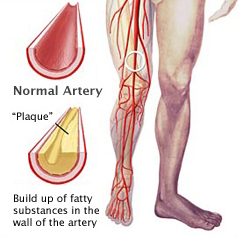
Diabetes & Peripheral Vascular Disease: The Special Connection
This serious diabetes complication can develop as a result of uncontrolled blood sugar levels.
TYPE 2 DIABETES
In Diabetes, the blood glucose (sugar) levels are too high for too long, or swing back and forth between highs and lows. People with diabetes put themselves at risk for serious complications and damage to their bodies. Peripheral vascular disease (PVD) is one of the medical complications that can strike if type 2 diabetes is not well managed.
Peripheral vascular disease includes several conditions that affect the blood vessels. PVD occurs when peripheral blood vessels, those located away from the heart, become blocked or damaged in some way. Peripheral artery disease, or PAD, is one type of PVD; it affects arteries in the arms and legs.
Symptoms of Peripheral Vascular Disease (PVD)
The main symptoms of peripheral vascular disease include:
-A heavy feeling in the limbs
-Pain in the buttocks or extremities, including the thighs or calves
-A blue tint to the toes
-Feeling of Numbness in the legs or feet
-Cold feet
-Leg cramps, which often increase with more activity & relieve on rest
-Skin redness
-Frequent infections
-Foot pain
-Wounds on the feet and toes that won’t heal
Causes of PVD
PVD occurs when plaque composed of cholesterol and other fatty substances found in the blood, builds up and creates a blockage in the blood vessels, obstructing the blood from flowing properly.
Peripheral vascular disease can be caused or worsened by:
-Having high blood pressure
-High cholesterol levels and fats in the blood
-Smoking
-Having persistent high blood glucose levels
Prevention and Treatment of PVD
People with diabetes can Live Life More by protecting themselves against PVD and keeping their blood vessels clear. Start by achieving good control over your diabetes with these steps:
-Take all diabetes medications as prescribed by your doctor.
-Keep blood pressure and cholesterol at healthy levels, with medication if necessary.
-Eat a healthy diet, one that’s low in salt, cholesterol, and fat.
-Get regular exercise.
-Maintain a healthy body weight.
-Don’t smoke.
Make sure that your blood glucose levels are stable — talk to us if you’re having difficulty achieving this.
It is advisable to regularly inspect and take good care of your feet and skin to prevent wounds and infections. Be on the lookout for blisters, sores, and any painful or red areas on the feet.
Making some lifestyle changes and adopting healthy habits to maintain good control over diabetes will also help to treat any existing PVD. In very serious cases, when a blood vessel is severely blocked, surgery may be needed to re-route blood flow around the blockage using a blood vessel grafted from elsewhere in the body. Blockages can also be treated with angioplasty, a procedure in which a catheter with a balloon device is inserted in the blood vessel and inflated to clear the vessel; in some cases, a tube called a stent is placed inside the blood vessel to keep it open and allow blood to flow efficiently throughout the body.
As a prevention oriented organisation, we would say that though PVD can be treated to relieve symptoms, prevention is really the best medicine. Carefully monitor your blood glucose levels and focus on healthy habits to keep your blood vessels clear.
Opt for our Diabetes Management Diet & Lifestyle Plan by logging on to our eClinic at www.livelifemore.zest.md
What is Lifestyle modification & why is it, the need of the hour ?
Lifestyle is the way you live your life; what you eat, how and when you eat, how much you exercise, how you cope with stressful situations. Lifestyle Modification is a pro-active approach towards optimum health & wellness by bringing about appropriate changes in the way you live to Live Life More.
It is the need of the hour because the biggest killer in the world today accounting for almost 80% deaths worldwide is not war, disease, natural calamities or accidents. The biggest killer is, Lifestyle. Wrong diet; lack of physical activity and exercise; Obesity; mental stress and tensions of fast paced competitive life; pollution; alcohol and smoking are the major culprits; which manifest themselves innocently as high blood pressure, diabetes or high blood cholesterol and then without warning, strike fatally as heart attacks, stroke or cancer. They can potentially cut short the lives (mortality) or disable the patients (Morbidity) in the most productive years of their lives. Hence, one has to realize that one’s lifestyle plays a crucial role in “remaining healthy”.
So, a scientifically planned and logically guided healthy lifestyle is the cornerstone to preventing disease and attaining Optimum Health and Well-being.
Is Lifestyle Modification difficult?
Contrary to popular belief, leading a healthy lifestyle doesn’t have to be difficult; it doesn’t have to be painful or time-consuming. Making gradual, simple changes in your diet and physical activity will make great improvements in your health and well-being, and they can drastically reduce your risk of disease or complications of disease if it already exist.
Can Lifestyle Modification help in conditions like Heart Disease, Hypertension, Diabetes, obesity etc?
For people already diagnosed or with a family history of degenerative diseases like heart disease, diabetes, cancer etc, an active lifestyle can slow or stop the process for all but those with serious genetic disorders. Studies have shown that a comprehensive lifestyle intervention program that includes regular scientifically planned physical activity, a tailored healthy diet and a stress reduction program can “Add years to life, add life to years” i.e. it can prolong the life-span, improve your quality of life by controlling and even reversing the reversible disease process.
Evidence also shows that an active lifestyle and its capability in reducing body fat, is associated with a reduced risk for some types of cancers: prostate for men, breast and uterine cancers for women.
In addition, regular physical activity and a healthy diet are successful in treating non-insulin dependent diabetes (NIDDM); for some patients, it has reduced or eliminated the need for insulin substitutes. In general, regularly active adults have 42 percent lower risk of developing NIDDM.
How can LiveLifeMore help in Lifestyle Modification?
LivelLfeMore can teach you how to break out of the diet mentality and change your lifestyle in simple, yet very effective ways so you can not only add years to your life, but life to your years. Our program is not another 90-day prison sentence sure to fail; it is the beginning of an improved, more beneficial way to live.
The approach of our Lifestyle Management Programs for Healthy Living and for conditions like Hypertension, diabetes, heart disease etc. have no strict rules to follow; the approach doesn’t deprive you of the foods you love. LivelifeMore can teach you how to make smart choices when shopping, cooking, and eating out; it teaches you how to make healthy decisions about exercise. It can help you learn how to think in ways that will make an amazing difference in how you look, act, and feel. As these new habits become permanent, you will have mastered the healthy lifestyle everyone deserves to enjoy. With Livelifemore.com, you can adopt gradual, realistic changes into your life that will make healthy eating and activity a permanent pleasure.
By the end of your program with us, you will have recommendations designed just for you to start you on your journey to optimal health. These recommendations will include changes to be made in nutrition, exercise, supplements like anti-oxidants, stress management and more. But how do you make those modifications?
Developing healthy habits is not easy. Like learning a new skill, it will take motivation, time, patience, and most of all – practice! And, when learning a new skill, most of us do better if we have a coach or guide. Our team comprising Integrative Health Consultant Dr. Dr. Sandeep Jassal and Nutritionist Pallavi Jassal along with the inputs from the top super-specialists from nearly all the specialities and streams of health-care, will serve as your coaches in a weekly program designed to help you achieve your goals.
In our Lifestyle Modification Program, the client will meet one of our experts turn by turn every week at a mutually convenient time (Online or in person by appointment). Dr. Dr. Sandeep Jassal and Pallavi Jassal will help you problem-solve any difficulties you may be experiencing with any aspect of the program. Also, each week there will be different educational topics, including:



